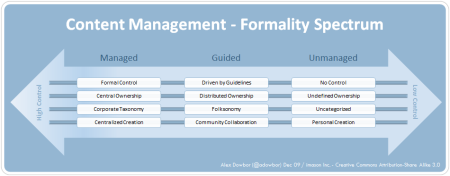March 16, 2013
The inability to iterate is a recurring characteristic of most large companies I worked with, and in my opinion is one of they key obstacles they face to allow innovation to occur. This becomes particularly visible and painful when solutioning for complex problems, to which the answer is not readily known.
The second characteristic that appears to go hand in hand with the first one, is that they all have a discourse of becoming more agile and innovative – even though all their processes, actions and funding models are geared towards the “build once & deploy” paradigm. There is obviously a gap between the desire to produce innovation and the infrastructures in place to support it. Under these structures, these companies become, at most, good at delivering against predictable problems – problems to which solutions are relatively evident and can be planned from back to be start. Although this is a great skill, it will not help the company successfully tackle complex problems that require innovative solutions.
This is one of the key reasons these same companies typically have less than ideal intranets and collaboration systems – because these are problems for which the use of the “build once & deploy” prescriptive solution approach will typically fail.
Allowing for iterations should be viewed as a strategic element for creating a sustainable ecosystem that suports innovation.


 Leave a Comment » |
Leave a Comment » |  Chart, Enterprise 2.0, Innovation | Tagged: Creativity, Innovation, Iteration |
Chart, Enterprise 2.0, Innovation | Tagged: Creativity, Innovation, Iteration |  Permalink
Permalink
 Posted by ornot
Posted by ornot
March 7, 2011
With the ever-growing sea of digital information within and outside our organizations, comes the natural need to be able to navigate through it all and find what we are looking for – or even better, have the right information find us. The power law that most of us are used to in the context of e-commerce also applies directly to search. The curve below is typical of any search application, showing a high concentration of “hits” on the most popular keywords followed by a very long tail of low hits (down to one time queries).
Understanding this behaviour is important in order to optimize and tune the search experience, as specific tools and techniques are available to deal with the different sectors of the curve. While the “head” is prone to manual intervention allowing content managers to bias known results to ensure higher relevancy, the “tail” is where more sophisticated search platforms can make a difference by surfacing the otherwise buried information in ways that provide insight to the end-users. A good enterprise search experience will, among other things establish a conversation with the user helping him or her navigate and drill down to the right information.
Below are some of these techniques, from an imason enterprise search presentation.

 1 Comment |
1 Comment |  Chart, Enterprise 2.0, Search | Tagged: Long Tail, search experience, search tunning |
Chart, Enterprise 2.0, Search | Tagged: Long Tail, search experience, search tunning |  Permalink
Permalink
 Posted by ornot
Posted by ornot
February 25, 2011
Often in SharePoint 2010 implementations we see Portals, Team sites and Social sites being treated as separate conceptual entities. Although they have their own merits and add specific value individually, it is in “the intersection” where we find the ideal balance of flexibility, context and business alignment for open collaboration. Furthermore, in the intersection, the user experience allow us to easily flow between the different spheres and levels of formality.

Related post: Collaboration Atmosphere – chart

 7 Comments |
7 Comments |  Chart, Collaboration, Enterprise 2.0, Visualizing Information | Tagged: collaboration, Diagram, Enterprise 2.0, intranet 2.0, KM, Knowledge Management, SharePoint 2010, social intranet |
Chart, Collaboration, Enterprise 2.0, Visualizing Information | Tagged: collaboration, Diagram, Enterprise 2.0, intranet 2.0, KM, Knowledge Management, SharePoint 2010, social intranet |  Permalink
Permalink
 Posted by ornot
Posted by ornot
February 21, 2011

In the analogy, think of how the high gravity that exists closer to the sun and how it affects movement. The closer to the center the more rigid and formal everything is. By the same token, the further from the center, the more loose and disconnected things are.
- Rigid: portals managed centrally, typically by the communications department. Although too rigid for collaboration, they make for a good top down (tightly managed) communication channel where central control is important.
- Formal: departmental sites, managed in accordance to corporate structures. At this level, collaborations is structured and based on pre-defined groups. Mostly used to share managed documents at the departmental level. Regulated by the department and policies.
- Right Balance: not too structured not too loose. Governed by an evolving culture and guidelines. Although flexible to allow for non-anticipated types of collaboration and innovation (open collaboration), it is still connected enough to the enterprise goals and existing processes to produce tangible business value. This balance varies for each enterprise or organization.
- Loose: collaboration groups or initiatives that are still forming (emergent) and may flow towards mainstream by finding the “right balance” or drift towards the disconnected oblivion.
- Disconnected: so loose that it becomes disconnected. This includes the sprawl of collaboration sites that are disconnected from each other and at times from the organization as well. Although benign in small scales when it grows it aggravates problems such as data duplication, data quality and collaboration silos. Typically no policy, no guidelines and no visibility.
Related posts: Content Management Formality Spectrum & Social Network – The Intersection Diagram


 1 Comment |
1 Comment |  Chart, Collaboration, Enterprise 2.0, Visualizing Information | Tagged: Adoption, collaboration atmosphere, e20, formality spectrum, intranet 2.0, social intranet |
Chart, Collaboration, Enterprise 2.0, Visualizing Information | Tagged: Adoption, collaboration atmosphere, e20, formality spectrum, intranet 2.0, social intranet |  Permalink
Permalink
 Posted by ornot
Posted by ornot
December 9, 2010
I am enjoying reading Andy McAffe’s “Enterprise 2.0” book. Here is a bull-eye type chart illustrating the SLATE concept (Search, Links, Authorship, Tags, Extensions, Signals) that summarizes what he calls the “Emergent Social Software Platforms” (ESSPs).

 Leave a Comment » |
Leave a Comment » |  Chart, Enterprise 2.0, Visualizing Information | Tagged: Andy McAffe, collaboration, e20, Enterprise 2.0, intranet, SLATES |
Chart, Enterprise 2.0, Visualizing Information | Tagged: Andy McAffe, collaboration, e20, Enterprise 2.0, intranet, SLATES |  Permalink
Permalink
 Posted by ornot
Posted by ornot
August 12, 2010
Companies often try to deploy collaborative solutions that are disconnected from their business, and face serious adoption challenges as employees struggle to see their relevance and value. These solutions eventually fade away while the stakeholders wait for the cargo to arrive (see “cargo cult“) and users find other ways to communicate.
The transformational power of an Enterprise 2.0 initiative lies in fostering and/or amplifying a real collaborative culture using tools that over time will integrate with the organization’s core systems, data stores and business processes. This requires strong sponsorship, a cross-functional team and focus on culture and process change. The diagram below illustrates three key layers to deploy and sustain a collaborative platform.

Enablers provide the infrastructure and change management support that underpins the Enterprise 2.0 (or Intranet 2.0) initiative. They continuously adapt the infrastructure and remove obstacles to maintain the right conditions for success.
Stewards are the content catalysts that make sure the solution is always in motion. They break the initial inertia and work with enablers to keep momentum. They play a key role in sustaining and curating the platform. Stewards know how to navigate the waters to maximize the wind in their sail… and when there is no wind, they are the motor that keeps the sailboat moving.
Users represent the broadest layer and are ultimately what sustains everything else (no more sailing analogies?). Individuals play different roles at different times as their level of engagement and collaboration needs change over time.
I’d love to hear your feedback.
 5 Comments |
5 Comments |  Chart, Enterprise 2.0 | Tagged: collaboration, e20, intranet, social computing |
Chart, Enterprise 2.0 | Tagged: collaboration, e20, intranet, social computing |  Permalink
Permalink
 Posted by ornot
Posted by ornot





 Posted by ornot
Posted by ornot 










